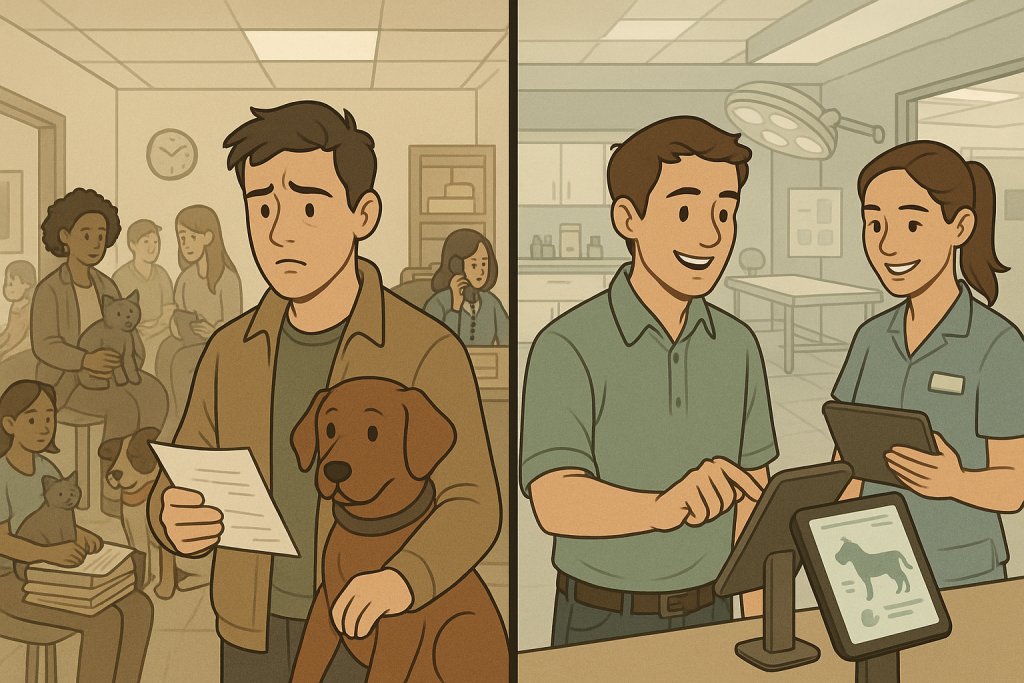By Bruce Gordon, CEO of Profit Solutions
After 38 years of helping businesses optimize their operations, I’ve discovered that veterinary practices sit on goldmines of untapped revenue opportunities. Every patient record, every treatment history, every seasonal pattern contains valuable insights that most practices never analyze. While veterinarians excel at animal care, they often miss the data-driven business opportunities that could transform their practice’s profitability.
The $480,000 Hidden Revenue Crisis in Veterinary Practices
Let me describe a scenario that perfectly illustrates the magnitude of missed opportunities in veterinary medicine. Recently, I consulted with a well-established veterinary practice with 3 doctors serving 4,200 active patients. Their clinical care was exceptional, their client relationships strong, but they were missing nearly half a million dollars in annual revenue opportunities hidden in their own data.
Here’s what their practice looked like on the surface:
- Annual revenue: $1.8 million with steady year-over-year growth of 8%
- Patient database: 4,200 active patients with 7 years of detailed treatment records
- Average client spend: $425 annually across all services
- Client retention: 73% annual retention rate, typical for the area
- Service mix: 60% routine care, 25% sick visits, 15% emergency/urgent care
- Seasonal patterns: Obvious busy periods but no systematic analysis
The hidden opportunities our analysis revealed:
- Preventive care gaps: 2,100 patients were overdue for recommended preventive treatments worth $890,000 annually
- Chronic condition management: 680 patients with chronic conditions receiving suboptimal ongoing care
- Breed-specific health opportunities: 1,240 patients at high risk for breed-specific conditions with no proactive intervention
- Seasonal revenue optimization: $180,000 in missed revenue from poor seasonal service timing
- Client lifecycle management: 34% of clients showed patterns indicating risk of switching practices
The financial impact of these missed opportunities:
- Preventive care revenue: $480,000 annually in overdue preventive treatments
- Chronic care optimization: $127,000 in ongoing management revenue
- Breed-specific prevention: $89,000 in proactive specialized care
- Seasonal optimization: $156,000 in better-timed service delivery
- Client retention improvement: $143,000 in prevented client attrition
Total hidden revenue opportunity: $995,000 annually—representing 55% increase in revenue potential using existing client base and services.
Why Traditional Veterinary Practice Management Misses Revenue Opportunities

Most veterinary practices operate reactively, treating animals when they’re brought in for care but missing opportunities for proactive health management and revenue optimization. They maintain detailed medical records but lack the analytical tools to identify patterns, predict needs, and optimize service delivery.
The Reactive Care Model Problem
Traditional veterinary practices focus on:
- Treating sick animals when they’re brought in for care
- Providing routine preventive care when owners remember to schedule
- Responding to emergencies and urgent situations as they arise
- Basic appointment scheduling and reminder systems
This reactive approach misses opportunities for:
- Proactive identification of health risks before they become expensive problems
- Systematic management of chronic conditions that require ongoing care
- Breed-specific prevention programs that clients value highly
- Optimal timing of preventive services based on individual animal needs
The Data Utilization Gap
Veterinary practices collect enormous amounts of valuable data but typically use it only for:
- Basic medical record keeping and treatment documentation
- Simple appointment scheduling and reminder systems
- Elementary financial reporting and tax preparation
- Insurance claims processing and compliance documentation
Meanwhile, this same data contains insights that could drive:
- Predictive health analytics for individual animals
- Population health management for entire client bases
- Revenue optimization through better service timing and recommendations
- Client retention strategies based on behavioral patterns
The Communication and Timing Challenge
Most veterinary practices rely on generic communication approaches:
- Annual reminder postcards for routine services
- Basic appointment confirmation calls or texts
- Reactive communication when problems arise
- One-size-fits-all health education materials
This approach misses opportunities for:
- Personalized health recommendations based on individual animal profiles
- Optimal timing of communications based on pet lifecycle stages
- Proactive education about breed-specific health concerns
- Targeted wellness programs that clients eagerly embrace
Transform Your Practice Communication While Building Data Analytics
Before implementing comprehensive machine learning systems, let me offer you something that can immediately improve your veterinary practice communication while capturing valuable data: a custom AI phone agent built specifically for veterinary practices – completely FREE.
Imagine having an AI assistant that can answer common pet health questions, schedule appointments, provide basic care information, and capture valuable client data for future analysis – all while your veterinary team focuses on providing excellent animal care.
🐾 Get Your Veterinary Practice AI Phone Agent:
✓ Pet Health Information – Answers common questions about symptoms, care, and treatments
✓ Appointment Scheduling – Books routine exams, vaccinations, and follow-up visits automatically
✓ Emergency Triage – Routes urgent situations to veterinarians while handling routine inquiries
✓ Medication and Care Reminders – Provides information about prescribed treatments and care instructions
✓ Client Data Capture – Collects valuable information for future machine learning analysis
✓ Multi-Pet Household Management – Handles complex scheduling for families with multiple animals
Your clients have questions at all hours. Your veterinary team needs to focus on animal care. Your practice needs systematic data collection for optimization.
👉 BUILD MY VETERINARY AI AGENT – FREE
No credit card required. Veterinary-trained AI ready in under 24 hours.
How Machine Learning Data Analysis Transforms Veterinary Practice Revenue

Modern machine learning systems don’t just organize veterinary data—they identify patterns, predict needs, and uncover revenue opportunities that transform reactive practices into proactive, highly profitable operations.
Predictive Health Analytics for Individual Animals
Machine learning systems analyze individual patient data to predict:
- Optimal timing for preventive care based on age, breed, lifestyle, and health history
- Risk factors for breed-specific conditions before symptoms appear
- Chronic condition progression requiring intervention or treatment adjustment
- Seasonal health needs based on individual animal patterns and local conditions
- Vaccination and preventive care scheduling optimized for maximum effectiveness
- Nutritional and lifestyle recommendations tailored to specific animal profiles
Population Health Management and Revenue Optimization
Advanced analytics identify practice-wide opportunities:
- Client segments with specific health management needs and revenue potential
- Service gaps where clients need care but aren’t receiving appropriate recommendations
- Seasonal demand patterns that enable optimal staffing and inventory management
- Geographic health trends that indicate community-wide prevention opportunities
- Revenue cycle optimization through better treatment timing and service bundling
- Capacity utilization improvements that maximize appointment availability and revenue
Client Lifecycle and Retention Analytics
Machine learning systems track client behavior patterns to:
- Predict client attrition before it occurs, enabling proactive retention efforts
- Identify high-value clients who would benefit from premium services
- Optimize communication timing based on individual client preferences and responsiveness
- Personalize service recommendations that clients are most likely to accept
- Track client satisfaction indicators through appointment and payment patterns
- Identify referral opportunities from satisfied clients with specific animal profiles
Case Study: Transforming a Multi-Doctor Veterinary Practice
Let me walk you through a comprehensive case study that demonstrates the real-world impact of machine learning data analysis on veterinary practice revenue:
The Practice: A four-doctor small animal practice serving suburban and rural markets, with 5,200 active clients and annual revenue of $2.4 million, known for excellent clinical care but struggling with revenue growth despite strong client relationships.
The Revenue Optimization Challenges:
- Revenue growth had plateaued at 3% annually despite 12% increases in local pet ownership
- Preventive care compliance was 62%, leaving significant revenue on the table
- Chronic condition management was reactive rather than proactive, missing ongoing revenue opportunities
- Client retention was 71%, below industry standards for practices with similar care quality
- Emergency and urgent care represented only 8% of revenue despite being the highest-margin services
- Seasonal revenue variations created staffing and cash flow challenges
The Machine Learning Data Analysis Solution:
- Implemented comprehensive patient data analysis system with predictive health modeling
- Created personalized preventive care recommendation engine based on individual animal profiles
- Deployed client behavior analytics to identify retention risks and optimization opportunities
- Built breed-specific health management programs using population data analysis
- Established seasonal demand forecasting with optimal resource allocation
- Integrated revenue optimization algorithms with appointment scheduling and service recommendations
Results After 18 Months:
- Annual revenue increased from $2.4 million to $3.1 million (29% growth)
- Preventive care compliance improved from 62% to 84% through personalized recommendations
- Chronic condition management revenue increased 156% through proactive ongoing care programs
- Client retention improved from 71% to 89% through predictive intervention strategies
- Emergency and urgent care revenue doubled through better client education and preparation
- Seasonal revenue variations reduced by 40% through demand forecasting and resource optimization
Financial Impact Breakdown:
- Preventive care optimization generated $340,000 in additional annual revenue
- Chronic condition management programs added $187,000 annually
- Improved client retention prevented $89,000 in lost revenue and generated $134,000 in additional services
- Seasonal optimization and capacity utilization improvements added $156,000 annually
- Total revenue increase: $906,000 with same staffing levels and facility capacity
Veterinary-Specific Machine Learning Applications

Different aspects of veterinary practice benefit from specialized machine learning approaches:
Small Animal Practice
Key Applications: Breed-specific disease prediction, vaccination optimization, chronic condition management, client communication personalization Revenue Opportunities: Preventive care programs, wellness packages, breed-specific services, chronic condition management plans
Large Animal/Equine Practice
Key Applications: Herd health analytics, seasonal care optimization, breeding program support, performance animal management Revenue Opportunities: Herd health contracts, breeding consultations, performance optimization services, preventive herd management
Emergency and Specialty Practice
Key Applications: Case complexity prediction, resource allocation optimization, referral pattern analysis, critical care outcome prediction Revenue Opportunities: Optimized case management, specialized service programs, referral relationship enhancement, critical care efficiency
Mixed Animal Practice
Key Applications: Multi-species health analytics, seasonal demand forecasting, client segmentation across species, cross-species disease monitoring Revenue Opportunities: Comprehensive farm services, multi-species wellness programs, seasonal service packages, integrated animal health management
Implementation Strategy for Veterinary Machine Learning
Successful implementation requires understanding the unique data patterns and care cycles in veterinary medicine:
Phase 1: Data Audit and System Integration (Weeks 1-4)
- Comprehensive analysis of existing patient records and treatment data
- Integration with practice management software and medical record systems
- Data cleaning and standardization for machine learning algorithm training
- Baseline establishment for current preventive care compliance and revenue patterns
Phase 2: Predictive Model Development (Weeks 3-8)
- Build individual animal health prediction models based on breed, age, and history
- Create client behavior analytics for retention and service optimization
- Develop seasonal demand forecasting models using historical appointment data
- Implement preventive care recommendation engines with personalized timing
Phase 3: Communication and Service Optimization (Weeks 6-12)
- Deploy personalized client communication systems based on machine learning insights
- Launch breed-specific and age-specific wellness programs
- Implement chronic condition management protocols with ongoing monitoring
- Create seasonal service campaigns optimized for individual client needs
Phase 4: Advanced Analytics and Expansion (Months 3-6)
- Add population health analytics for community-wide health trend identification
- Implement revenue optimization algorithms for service bundling and pricing
- Deploy advanced client retention strategies based on predictive analytics
- Create comprehensive business intelligence dashboard for strategic decision-making
Measuring Success: Veterinary Machine Learning KPIs

Veterinary practices should track these critical metrics to measure machine learning effectiveness:
Preventive Care Compliance Rate: Target improvement from typical 55-65% to optimized 80-90% through personalized recommendations.
Revenue per Client Growth: Measure annual revenue per client improvement. Expect 25-40% increases through optimized service recommendations.
Client Retention Rate: Track annual retention improvement. Well-implemented analytics should achieve 85-95% retention rates.
Chronic Condition Management Revenue: Measure ongoing care revenue for chronic conditions. Target 100-200% improvement through proactive management.
Seasonal Revenue Optimization: Track reduction in seasonal revenue variations. Expect 30-50% improvement in revenue consistency.
Predictive Care Accuracy: Monitor accuracy of health predictions and recommendations. Target 80-90% accuracy for major health event predictions.
Advanced Machine Learning Features for Veterinary Practices
Leading veterinary practices are implementing sophisticated machine learning capabilities:
Population Health Surveillance: AI systems that monitor community-wide health trends and disease outbreaks to enable proactive prevention and treatment strategies.
Genomic Data Integration: Machine learning that incorporates breed genetic information with individual health data for more precise health predictions and treatment recommendations.
Environmental Health Analytics: Systems that analyze local environmental factors, seasonal patterns, and geographic data to predict health risks and optimize care timing.
Treatment Outcome Prediction: AI that analyzes treatment success rates and patient characteristics to optimize treatment protocols and client expectations.
Economic Health Modeling: Advanced systems that balance optimal care recommendations with client economic factors to maximize both animal health and practice revenue.
The Client Experience Transformation

Machine learning analytics fundamentally changes how clients experience veterinary care:
Proactive Health Management: Clients receive personalized recommendations before health problems develop, creating better outcomes and stronger relationships.
Personalized Communication: All communications are tailored to individual pets and client preferences, creating more relevant and valuable interactions.
Transparent Care Planning: Predictive analytics enable clear communication about future health needs and associated costs, reducing surprises and building trust.
Optimal Care Timing: Machine learning ensures that preventive care and treatments are recommended at optimal times for maximum effectiveness and client convenience.
Educational Value: Data-driven insights provide clients with valuable education about their pets’ specific health needs and care requirements.
The Competitive Advantage of Data-Driven Veterinary Medicine
In veterinary medicine, machine learning analytics becomes a significant competitive differentiator:
Clinical Excellence: Data-driven care recommendations improve health outcomes, creating reputation advantages and client loyalty.
Revenue Optimization: Systematic identification of care opportunities generates significantly higher revenue per client than reactive practices.
Client Retention: Proactive, personalized care creates stronger client relationships and higher retention rates than traditional approaches.
Operational Efficiency: Predictive analytics optimize staffing, inventory, and capacity utilization for maximum profitability.
Market Expansion: Superior outcomes and client satisfaction enable practices to capture larger market share and premium pricing.
Implementation Considerations for Veterinary Practices

When implementing machine learning analytics, veterinary practices should consider:
Data Quality: Ensure accurate, complete medical records and client information for reliable machine learning model training.
Privacy Compliance: Implement appropriate data security measures to protect sensitive veterinary and client information.
Staff Training: Train veterinary staff to interpret and act on machine learning insights effectively.
Client Education: Help clients understand the value of data-driven care recommendations and proactive health management.
Technology Integration: Plan seamless integration with existing practice management software and medical record systems.
Taking Action: Your Path to Data-Driven Veterinary Success
The veterinary industry is evolving toward more sophisticated, data-driven care that improves both animal health outcomes and practice profitability. Practices that implement machine learning analytics gain significant advantages in clinical excellence, revenue optimization, and client satisfaction.
Your implementation strategy:
- Assess Your Data Assets: Analyze your current patient database and treatment records for machine learning potential
- Calculate Hidden Revenue: Identify how much revenue you’re missing through reactive-only care approaches
- Plan Technology Integration: Understand how machine learning systems will integrate with your existing practice management tools
- Develop Implementation Timeline: Create a phased approach that maintains clinical excellence during transition
- Train and Optimize: Ensure your team understands data-driven insights and continuously improves based on analytics results
Start Uncovering Hidden Revenue Today

While you’re planning comprehensive machine learning systems, you can immediately improve your veterinary practice communication and data collection with a custom AI phone agent built specifically for veterinary professionals.
🏥 Why Veterinary Practices Choose Our AI Phone Agents:
✓ Never Miss Client Calls – 24/7 availability for pet health questions and appointment scheduling
✓ Professional Veterinary Communication – Knowledgeable responses about common pet health issues and care
✓ Emergency Situation Triage – Routes urgent pet health situations to veterinarians immediately
✓ Appointment Optimization – Schedules routine care, vaccinations, and follow-ups efficiently
✓ Client Data Collection – Captures valuable information for future machine learning analysis
✓ Multi-Pet Household Management – Handles complex scheduling and care coordination for families with multiple animals
Real Veterinary Practice Results:
- Small Animal Clinic in Colorado: Increased preventive care appointments by 67% through AI-assisted client communication
- Multi-Doctor Practice in Texas: Improved client retention by 34% with 24/7 AI availability for routine questions
- Rural Veterinary Clinic in Iowa: Generated 23% more revenue from better appointment scheduling and client education through AI
Critical Veterinary Practice Communication Stats:
- 89% of pet owners have questions about their animals’ health outside of regular business hours
- Veterinary practices with excellent communication achieve 91% client retention rates vs. 68% industry average
- Proactive veterinary communication increases preventive care compliance by 78%
👉 GET MY FREE VETERINARY AI PHONE AGENT
Built for veterinary professionals who want to transform data into revenue while maintaining excellent animal care. Ready in under 24 hours. No credit card required.
Remember, every patient record in your database contains valuable insights about future health needs and revenue opportunities. Every breed-specific risk factor represents a prevention program opportunity. Every seasonal pattern indicates optimal service timing that most practices miss.
The veterinary practices that embrace machine learning analytics now will build sustainable competitive advantages through superior clinical care and optimized revenue generation. Those that continue operating reactively will miss the transformation toward data-driven veterinary medicine.
Your clients want the best possible care for their animals. Your practice deserves the revenue that comes from systematic, proactive health management. Your veterinary team needs the insights that machine learning provides for optimal care delivery.
Get all three working together with machine learning data analysis and AI-powered communication systems designed specifically for veterinary practice success.


